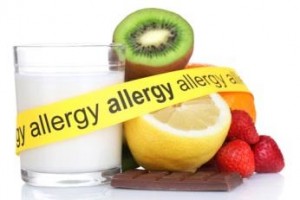 Incidents of food allergy seem to be on the rise, with more and more of us discovering we’re either medically allergic or intolerant to certain common foods. In extreme cases, food allergy can be life threatening, making it vital for food producers to accurately describe the ingredients of products on their packaging. Difficulties arise, however, with food imported from countries that don’t share each other’s labelling regulations. Another challenge for consumers is how to determine the risks involved in the vague allergy prevention labels saying foods ‘may contain traces’ of potential allergens. Researchers looked at the protocols in several different countries to make a case for an international standard for food allergen labelling.
Incidents of food allergy seem to be on the rise, with more and more of us discovering we’re either medically allergic or intolerant to certain common foods. In extreme cases, food allergy can be life threatening, making it vital for food producers to accurately describe the ingredients of products on their packaging. Difficulties arise, however, with food imported from countries that don’t share each other’s labelling regulations. Another challenge for consumers is how to determine the risks involved in the vague allergy prevention labels saying foods ‘may contain traces’ of potential allergens. Researchers looked at the protocols in several different countries to make a case for an international standard for food allergen labelling.
Background to the research
In Australia, food producers are legally required to include a list of ingredients on pre-packaged foods. Increasingly, we are also seeing ‘PAL’ – precautionary allergy labelling – which covers companies against the possibility of cross-contamination in the production process. This shows up as warnings such as ‘may contain traces of soy’ or ‘made in the same factory as products containing nuts’.
PAL in Australia is voluntary and there is debate here, and around the world, about its value. People who suffer allergies are entitled to as much information as possible about their food. On the other hand, some research shows that the vague nature of these labels leads to many people simply ignoring them – or to companies using them as an excuse not to bother monitoring or altering their production processes.
Australia, as a rule, has very high compliance standards for food production, including food imports. But, in a global food market, where the ingredients for one food item might be sourced from three different countries, it’s virtually impossible to keep track of the risks. The researchers refer to an Australian case study (2010) where peanut-allergic people suffered extreme reactions to a seafood product. This product used a soy flour coating made in China. The supply chain for the soy flour involved a number of companies, one of which had made changes to its production processes resulting in peanut contamination.
So, despite our growing understanding of the significance of food allergy, vague labelling and international inconsistencies mean we are still being put at risk when it comes to packaged foods.
Labelling around the world
Since 1999, most developed countries, and an increasing number of developing countries, have adopted some form of the World Heath Organisation’s codex on food labelling. It identifies wheat, gluten, egg, milk, peanut, tree nut, soy, fish and crustaceans as key potential allergens and suggests two levels of labelling: one for products that actually contain one of these ingredients, and one for potential cross-contamination.
In most countries with awareness of the issues, level 1 is mandatory and level 2 is not. Definitions of allergy producing foods also vary from country to country. For example, pine nuts are considered seeds in the EU (so, not declarable as tree nuts); whilst coconut is considered a tree nut in the USA (but not in Australia). And even in countries that have adopted these labelling procedures, the methods of policing them may differ.
The impact for consumers
Whilst food producers and governments weigh up the pros and cons of these regulatory systems, consumers are left confused about what they can and cannot eat. One study from the UK found that 69% of cereals had a ‘may contain nuts’ warning, despite not having nuts as an ingredient. For producers, this is a way of covering themselves against accidental contamination, particularly if they use imported ingredients. But this over-use is dulling the impact of the warnings, so that some consumers begin to find the PAL meaningless. If, on the other hand, consumers do heed these warnings strictly, they are likely to pay an average of 11% more for the weekly groceries thanks to choosing alternative products, potentially unnecessarily. Japan and Switzerland are leading the way in laws that link a threshold of potential allergens with labelling; so, a way of defining what counts as a ‘trace’. Australian scientists have also developed a testing system (VITAL) that gives a realistic measure of the trace elements of a protein present at the production stage in a factory. An agreed upon threshold might mean PAL only needs to be applied to particular cases, giving the consumer more confidence in the labels.
The research concludes that there is much more research to be done! But it seems clear than consistent allergen labelling regulations would benefit consumers and international trade across the current global food market.
References:
K J Allen, PJ Turner, et al. (2014) Precautionary labelling of foods for allergen content: are we ready for a global framework? World Allergy Organisation Journal, 7(1), 10-24.

